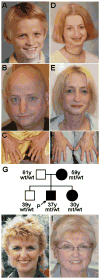Coronary artery disease in a Werner syndrome-like form of progeria characterized by low levels of progerin, a splice variant of lamin A
- PMID: 22065502
- PMCID: PMC4679285
- DOI: 10.1002/ajmg.a.34336
Coronary artery disease in a Werner syndrome-like form of progeria characterized by low levels of progerin, a splice variant of lamin A
Abstract
Classical Hutchinson-Gilford progeria syndrome (HGPS) is caused by LMNA mutations that generate an alternatively spliced form of lamin A, termed progerin. HGPS patients present in early childhood with atherosclerosis and striking features of accelerated aging. We report on two pedigrees of adult-onset coronary artery disease with progeroid features, who were referred to our International Registry of Werner Syndrome (WS) because of clinical features consistent with the diagnosis. No mutations were identified in the WRN gene that is responsible for WS, among these patients. Instead, we found two novel heterozygous mutations at the junction of exon 10 and intron 11 of the LMNA gene. These mutations resulted in the production of progerin at a level substantially lower than that of HGPS. Our findings indicate that LMNA mutations may result in coronary artery disease presenting in the fourth to sixth decades along with short stature and a progeroid appearance resembling WS. The absence of early-onset cataracts in this setting should suggest the diagnosis of progeroid laminopathy. This study illustrates the evolving genotype-phenotype relationship between the amount of progerin produced and the age of onset among the spectrum of restrictive dermopathy, HGPS, and atypical forms of WS.
Copyright © 2011 Wiley Periodicals, Inc.
Figures


References
-
- Chen L, Lee L, Kudlow BA, Dos Santos HG, Sletvold O, Shafeghati Y, Botha EG, Garg A, Hanson NB, Martin GM, Mian IS, Kennedy BK, Oshima J. LMNA mutations in atypical Werner’s syndrome. Lancet. 2003;362:440–445. - PubMed
-
- De Sandre-Giovannoli A, Bernard R, Cau P, Navarro C, Amiel J, Boccaccio I, Lyonnet S, Stewart CL, Munnich A, Le Merrer M, Levy N. Lamin a truncation in Hutchinson–Gilford progeria. Science. 2003;300:2055. - PubMed
-
- Eriksson M, Brown WT, Gordon LB, Glynn MW, Singer J, Scott L, Erdos MR, Robbins CM, Moses TY, Berglund P, Dutra A, Pak E, Durkin S, Csoka AB, Boehnke M, Glover TW, Collins FS. Recurrent de novo point mutations in lamin A cause Hutchinson–Gilford progeria syndrome. Nature. 2003;423:293–298. - PMC - PubMed
-
- Friedrich K, Lee L, Leistritz DF, Nurnberg G, Saha B, Hisama FM, Eyman DK, Lessel D, Nurnberg P, Li C, Garcia FVMJ, Kets CM, Schmidtke J, Cruz VT, Van den Akker PC, Boak J, Peter D, Compoginis G, Cefle K, Ozturk S, Lopez N, Wessel T, Poot M, Ippel PF, Groff-Kellermann B, Hoehn H, Martin GM, Kubisch C, Oshima J. WRN mutations in Werner syndrome patients: Genomic rearrangements, unusual intronic mutations and ethnic-specific alterations. Hum Genet. 2010;128:103–111. - PMC - PubMed
Publication types
MeSH terms
Substances
Grants and funding
LinkOut - more resources
Full Text Sources
Other Literature Sources
Medical
Molecular Biology Databases
Miscellaneous

